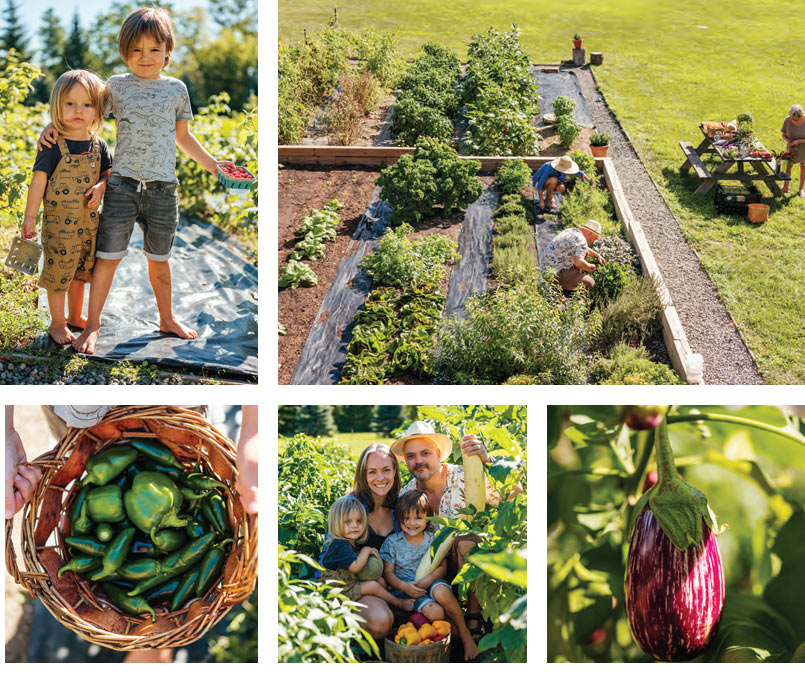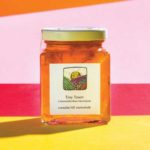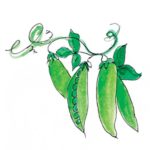
Every growing thing begins with a small, seemingly insignificant seed.
For Sarah Soetens and chef Hidde Zomer, it all started with some seedlings. These particular seedlings ended up in the two-acre backyard garden they own, appropriately named Millpond Gardens, after Bloomfield’s Mill Pond, which borders their property.
“A local farmer who supplies our restaurant had some rare heirloom beans that we wanted to try,” explains Sarah, a gardener herself, and the co-owner along with Chef Hidde of Bloomfield’s Flame + Smith restaurant. “They didn’t have time to process the seeds, so we took the plants, processed the seeds, and kept a few to plant in our gardens at the Millpond.”
“Sharing in the process of growing food responsibly has always been a part of our food philosophy, so we don’t mind putting in the work to try new varieties and contribute to our local farming community,” adds Hidde.
Hidde and Sarah have certainly put in the work. They have spent several years making sure that their restaurant is not only sustainable, but sustaining. They have worked hard to establish relationships with local farmers who understand and support regenerative farming practices. And when they decided to grow their own vegetables and herbs for the restaurant, the farmers were there with advice.
Building on that advice, the couple has reaped what they’ve sown many times over. “We could sustain our family for the whole year with the produce we grow, if we didn’t use it at the restaurant,” says Hidde. Millpond Gardens is not just a garden and natural play area for the couple’s six- and three-year-old sons, it’s also a training ground for the restaurant’s chefs and staff. Hidde insists they all spend at least an hour a week enjoying the lush gardens and helping to harvest the produce.
“I bring the staff over because I believe that spending time in the gardens makes you a better chef,” explains Hidde. “It helps them understand how long things take to grow and when different crops are in season,” he says, “as well as the value of whole foods.”
Hidde’s food philosophy was influenced by the lessons learned working in Amsterdam (Hidde was raised in The Netherlands). At De Kas, an old city greenhouse that was repurposed into one of the first “farm-to-table” restaurants in the world, the chefs frequently consulted the in-house botanist and adapted the menu to suit the growing season, sourcing much of the food from on-site gardens.
“De Kas was a true “plant-to-plate” operation, where the menu changed daily. You used whatever you could harvest that day,” he remembers. “The challenge was coming up with a dish in the short trip from the garden to the kitchen. Then you had to create it, and waste nothing, because you were aware of all the labour that went into growing it.”
There were some groundbreaking dishes. “We made spiced tomato jams when there was a bumper crop, we would ferment or dry vegetables, we even made our own schnapps and brandy with the fruit and herbs,” Hidde recalls.
“Experimenting with edible flowers and foraged food is more commonplace now. But making the connection between the source and your food was a new idea back then,” he comments.
Hidde finds more inspiration to create new dishes from their garden than from any cookbook. “For instance,” he says, “my lemon verbena-infused crème brûlée was created after a walk in the garden when the lemon aroma was scenting the air.”
“Growing your own food is a privilege,” Sarah says. “We’re lucky that our boys can plant peas and pick berries and are exposed to different varieties of fruits and vegetables. They are active participants in the garden; we give them the tools and they decide what to grow and take care of their plants as much as they can. While at the restaurant they see how those foods are prepared and they understand the value of the labour involved.”
There’s also been appreciation from an unexpected source. Sarah explains how growing their own food has sparked some of their urban friends’ awareness of what they are trying to achieve.
“I was really happy when some of our friends in the city took up gardening and sourdough bread baking,” she says. “Those who succeeded, cultivated a taste for fresh, whole foods and will continue to grow more for themselves, and that is wonderful.”
As for the ones who weren’t so enamoured of the practice, Sarah still thinks it wasn’t a total loss. Even those who would rather leave it to someone else are now empowered to make better food decisions. They understand the underlying value of an expensive loaf of handmade bread and recognize the importance of buying seasonal, local produce.
“They also made loads of new friends by giving away their sourdough starter,” she adds with a smile. Making decisions based on their food philosophy and not just strict corporate margins was very important when starting their own restaurant.
“Growing your own food is a privilege. We are lucky that our boys can plant peas and pick berries and are exposed to different varieties of fruits and vegetables.”
SARAH SOETENS
“We make decisions based on completely different considerations,” Hidde explains. “Our menu is created with local meats, cheeses, produce and wine. We choose to work with farmers who are striving to improve, and we want to support their journey, just as they support ours.”
He remembers a recent evening at the restaurant that confirmed the strength of his community support.
“It’s been a yo-yo year of openings and closings. On the night before we had to close again, we realized we were at capacity for what was allowable. And despite the fact it was only about ten degrees outside, the community had come out – dressed with extra sweaters – to enjoy a last night out together. The energy was electric, even though we were outside and socially distanced! We had music softly playing, the ovens were lit, and I was serving grilled meats, and our vegetables. We had a magical evening.”
He adds, “It started with a garden, with an idea to live and work in a more sustainably-minded way. Produce from that garden helped create that magical evening of dining, and that in turn, feeds the dream.”
Story by:
Micol Marotti
Photography by:
Johnny C. Y. Lam




